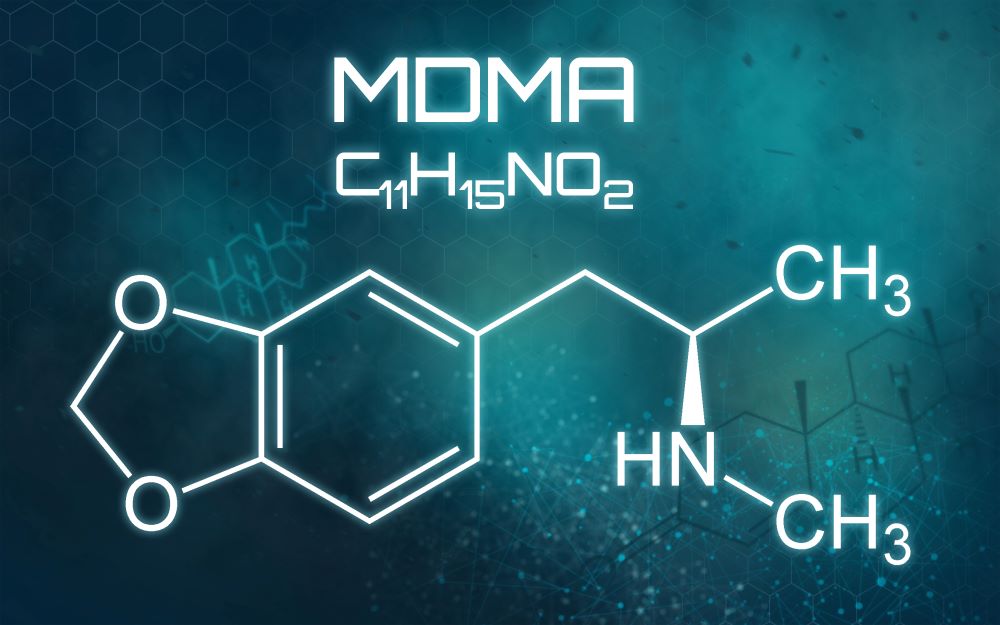MDMA
What Is MDMA? An Introduction
The article What Is MDMA? An Introduction was originally published on Microdose.
Microdose is devoting the month of May to an exploration of MDMA (MDMay,…

The article What Is MDMA? An Introduction was originally published on Microdose.
Microdose is devoting the month of May to an exploration of MDMA (MDMay, get it?). Today, we start with an introductory look at What Is MDMA? Stay tuned for more on molly throughout the coming weeks
MDMA, also known as Molly (and the main component in Ecstacy), is a synthetic psychoactive drug that’s moved from the underground rave scene to the cusp of FDA approval. But what is MDMA? This article provides an in-depth look at what MDMA is, its history, effects and more.
The History of MDMA
MDMA, or 3,4-methylenedioxymethamphetamine, was first synthesized in 1912 by German pharmaceutical company Merck. However, it wasn’t until the 1970s that the drug gained popularity as a psychotherapeutic tool. American chemist Alexander Shulgin re-synthesized MDMA in 1976 and introduced it to psychologists who began using it as an adjunct to therapy. During the 1980s, MDMA became a popular recreational drug and was made illegal in the United States in 1985.
Effects of MDMA
The effects of MDMA are a combination of stimulant, empathogen, and hallucinogenic properties. Users typically experience an increase in energy, euphoria, emotional warmth, and a distorted sense of time and space. The drug also enhances sensory perception, which can lead to an intensified appreciation for music and touch.
Emotional and mental reactions are caused by increases in serotonin, dopamine, and norepinephrine, triggering hormones that stimulate sexual arousal, trust, emotional closeness, elevated mood, and empathy.
Nicknamed the “love drug”, MDMA effects also include the promotion of sensual feelings and pro-social behaviour.
How Long Does MDMA Last?
MDMA’s effects generally begin within 30 to 60 minutes after ingestion and last for about 3 to 6 hours. Some users may experience lingering effects or “afterglow” for several days after use. However, it’s important to note that individual experiences can vary based on factors such as dosage, metabolism, and personal tolerance.
How Long Does MDMA Stay in Your System?
The half-life of MDMA is approximately 7 to 9 hours, meaning that half of the drug is eliminated from the body within that time frame. It can take up to 2 to 4 days for the drug to be completely eliminated from the system. However, drug tests can detect MDMA metabolites in urine for up to 3 to 5 days after use and in hair samples for several months.
Dosage of MDMA
The appropriate dosage of MDMA varies based on factors like body weight, sensitivity, and desired effects. A common recreational dose ranges from 50 to 125 milligrams. Higher doses can increase the risk of adverse effects and potential harm.
Can You Overdose on MDMA?
Although rare, it is possible to overdose on MDMA. Overdosing can lead to symptoms like high blood pressure, rapid heartbeat, seizures. Overheating and dehydration are also significant risks, particularly when MDMA is used in hot or crowded environments like clubs or music festivals.
Is MDMA Legal?
MDMA is currently illegal in most countries, including the United States, where it is classified as a Schedule I controlled substance. However, there is ongoing research and advocacy for the potential medical benefits of MDMA, particularly in the treatment of post-traumatic stress disorder (PTSD).
MDMA is currently in the second stage of a Phase 3 trial by MAPS and is expected to be approved by the FDA for medical use sometime in 2024.
For more on MDMA, check out An Overview of MDMA & MDMA Therapy in the Modern Psychedelic Renaissance
Editor’s Note: Some passages of this text were produced using ChatGPT
mdma ecstacy psychedelic psychoactive therapy ptsd dopamine serotonin hallucinogenic fda research
-

 Psilocybin1 week ago
Psilocybin1 week agoCalifornia advances bill for psychedelics centers
-

 Psilocybin5 days ago
Psilocybin5 days agoPassover Perspectives: Psychedelics, Moses, and the Burning Bush
-

 Psychedelics1 week ago
Psychedelics1 week agoPsychedelics Can Offer More Than Therapy On Its Own
-

 Psychedelics5 days ago
Psychedelics5 days agoAlgernon NeuroScience and the Centre for Human Drug Research to Present DMT Phase 1 Stroke Clinical Data at the Interdisciplinary Conference on Psychedelic Research June 6 – 8th, 2024
-

 Psychedelics5 days ago
Psychedelics5 days agoRevive Therapeutics Announces Type C Meeting Request Granted by FDA for Clinical Study of Bucillamine to Treat Long COVID
-

 Psychedelics5 days ago
Psychedelics5 days agoatai Life Sciences Announces Dosing of First Patient in Part 2 of Beckley Psytech’s Phase 2a Study Exploring BPL-003 Adjunctive to SSRIs in Patients with Treatment Resistant Depression
-

 Law & Regulation5 days ago
Law & Regulation5 days agoTryp Therapeutics merger with Exopharm approved by shareholders
-

 Psychedelics5 days ago
Psychedelics5 days agoOptimi Health and Kwantlen Polytechnic University Applied Genomics Centre Partner to Advance Mushroom Science and Research






